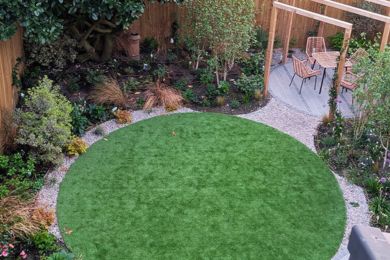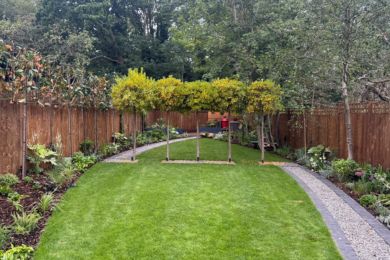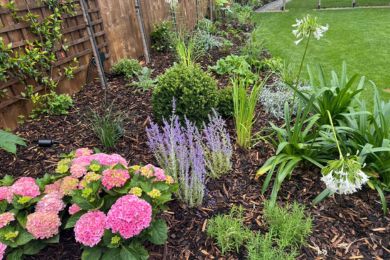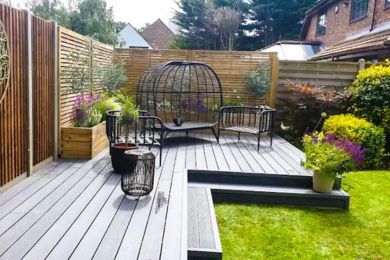Tidy Up Your Landscape With These Autumn Garden Maintenance Tips
A well-maintained garden requires more than just regular watering and occasional weeding. To prepare your garden for the colder months, autumn garden maintenance is essential for keeping your outdoor space healthy and resilient.
Autumn garden maintenance forms the backbone of a thriving outdoor space, helping prevent plant disease, water damage, and general deterioration that can turn your beautiful garden into a costly headache.
Whether you’re preparing for harsh winter weather or transitioning between growing seasons, a thorough garden tidy-up protects your investment whilst keeping your outdoor space looking its absolute best. These efforts are especially important as you adapt your garden to the changing seasons, ensuring plants and lawns remain robust. From cutting back spent annuals to safeguarding delicate furniture, these essential tasks ensure your garden remains healthy and vibrant year-round.
At SilvaTree, we’ve helped countless UK homeowners transform their outdoor spaces through expert garden design and landscaping. Our professional garden care team understands that proper timing and technique make all the difference between a garden that merely survives and one that truly flourishes.
This comprehensive guide covers the fundamental autumn garden tidy-up tips every homeowner should know: pruning and dividing plants, cleaning gutters and drainage systems, and protecting valuable garden elements from harsh weather conditions.
Top Autumn Maintenance Tasks For Your Outdoor Space
Regular seasonal maintenance transforms potentially overwhelming tasks into manageable routines that keep your garden healthy and beautiful throughout the year. Preparing your garden for the colder months is essential to ensure plant health and resilience, with essential autumn maintenance tasks such as:
1) Cut Back Dead Annuals and Divide Overcrowded Perennials
Dead annuals aren’t just unsightly, as they can become breeding grounds for pests and diseases that threaten your entire garden’s health. These spent plants consume valuable soil nutrients without contributing any visual appeal or ecological benefit.
By removing them promptly, you create space for new plantings whilst eliminating potential sources of fungal infections and pest infestations.
Annual plants complete their entire life cycle within a single growing season. Once they’ve finished flowering and set seed, they naturally begin to decline. Leaving these deteriorating plants in your borders can attract slugs, snails, and various garden pests seeking shelter and decomposing organic matter.
Overcrowded perennials struggle to produce their best displays. When clumps become too dense, individual plants compete fiercely for nutrients, water, and light. This competition results in weaker growth, fewer flowers, and increased susceptibility to disease.
Dividing established perennials reinvigorates the parent plant whilst providing you with new specimens to expand your garden or share with fellow gardeners. Most herbaceous perennials benefit from division every three to five years, though some vigorous spreaders may require annual attention.
Step-by-Step Plant Division
Timing matters immensely when dividing perennials during autumn garden maintenance. Early autumn or late winter provides ideal conditions, allowing plants to establish new root systems before facing summer stress or winter dormancy.
Begin by carefully lifting the entire clump using a garden fork, working around the plant’s perimeter to minimise root damage. Shake off excess soil to reveal the plant’s natural division points. Many perennials will naturally separate into distinct crowns or sections.
For stubborn clumps, use two garden forks placed back-to-back in the centre of the clump. Gently work the forks apart to split the plant. Alternatively, a sharp spade or knife can cleanly cut through dense root systems. Each division should have healthy roots and several growing points or shoots.
It is essential to always use sharp, clean tools when cutting back plants or dividing perennials. Blunt tools can crush plant tissues, creating entry points for diseases. Clean tools with disinfectant between plants to prevent spreading infections throughout your garden.
Replant divisions immediately at the same depth they were previously growing. Water thoroughly and apply a light mulch to help retain moisture during the establishment period. Don’t forget to compost healthy plant material, as it’s an excellent way to recycle nutrients back into your garden ecosystem by adding it to your compost heap, enriching it for future use.
For more inspiration regarding autumn planting and what you can incorporate in your garden this season, check out our blog post on How To Add Autumn Colour To Your Garden With Seasonal Planting.
2) Clean Out Gutters and Drains to Prevent Blockages
Blocked gutters and drains pose serious threats to both your property and garden. When autumn leaves, twigs, and garden debris accumulate in guttering systems, water overflow can damage foundations, create damp problems, and wash away valuable topsoil from planted areas.
Overflowing gutters often deposit large volumes of water directly onto garden beds, potentially drowning plants or washing away recently sown seeds. Additionally, standing water in blocked drains creates ideal breeding conditions for mosquitoes and other unwanted insects.
Safe Gutter Cleaning Techniques
Safety must be your absolute priority when cleaning gutters during your autumn garden maintenance. Never attempt this task during windy or wet conditions, and always ensure your ladder is properly secured with someone to spot you.
Start by removing large debris by hand, working systematically along each section of guttering. A garden trowel or specially designed gutter scoop helps remove compacted leaves and sediment. Place debris directly into a bucket or tarp rather than dropping it onto plants below.
Once you’ve cleared the bulk of the debris, flush the gutters with a garden hose to check for proper water flow and identify any remaining blockages. Pay particular attention to downpipes, which often harbour hidden obstructions.
Essential Gutter Cleaning Equipment
Invest in proper equipment to make gutter cleaning safer and more effective. A sturdy ladder with stabiliser bars prevents damage to guttering whilst providing secure support. Heavy-duty gloves protect your hands from sharp debris and potential contaminants.
A telescopic gutter cleaning tool allows you to clear some sections without constantly repositioning your ladder. These tools feature angled scoops specifically designed for gutter profiles and can significantly reduce the time spent on this essential maintenance task.
Consider scheduling professional gutter inspections annually, particularly for multi-storey properties or complex roof systems.
Drain Maintenance Essentials
Don’t overlook ground-level drains and drainage channels around your property. These systems prevent water from pooling around foundations and protect garden areas from flooding during heavy rainfall.
Remove visible debris from drain covers and use a garden hose to flush channels clear during your autumn garden maintenance. For stubborn blockages, a drain rod or plumber’s snake may be necessary.
Regular maintenance prevents minor blockages from developing into major drainage problems requiring professional intervention.
3) Store or Cover Delicate Pots and Garden Furniture
UK weather can be particularly harsh on garden furniture and decorative containers during the autumn and winter. Terracotta and ceramic pots are especially vulnerable to freeze-thaw cycles that can cause cracking or complete structural failure. Wooden furniture suffers from prolonged exposure to moisture, leading to rot, warping, and joint deterioration.
Metal furniture faces its own challenges, with rust and corrosion developing rapidly in damp conditions. Even supposedly weather-resistant materials benefit from proper protection during the harshest months of the year, and this should be done as part of your autumn garden maintenance.
Preparing Furniture for Storage
Thorough cleaning before storage prevents long-term damage and makes spring setup much more pleasant. Remove all dirt, organic matter, and stains using appropriate cleaning products for each material type.
Wooden furniture requires particular attention. Check for loose joints, protruding nails, or areas where water might collect. Apply appropriate wood preservative or oil to maintain the timber’s condition during storage.
Allow everything to dry completely before covering or storing to prevent trapped moisture from causing problems.
Metal furniture benefits from inspection for chips in protective coatings. Touch up any damaged areas with appropriate paint or rust inhibitor to prevent corrosion during damp winter months.
Container Plant Protection
Potted plants need special consideration during harsh weather periods. Containers can be moved to protected areas such as unheated greenhouses, conservatories, or even garages for the most delicate specimens.
For containers that must remain outdoors, group them together in a sheltered location, such as against a south-facing wall. This creates a microclimate that’s several degrees warmer than exposed positions. Wrap containers in bubble wrap or hessian to provide insulation, ensuring drainage holes remain clear to prevent waterlogging.
Raise containers off the ground using pot feet or bricks to improve drainage and prevent the base from freezing to hard surfaces. This simple step in your autumn garden maintenance can significantly reduce the risk of cracking from thermal expansion and contraction.
4) Autumn Lawn Care and Maintenance
Using proper lawn maintenance techniques enables homeowners to establish a lush, vibrant centrepiece that consistently enhances garden aesthetics.
It is essential to provide appropriate attention during autumn months, as this establishes the foundation for ensuring optimal grass health throughout challenging winter conditions and enables vigorous regeneration when spring temperatures return.
As environmental conditions shift with decreasing temperatures and reduced daylight exposure, your lawn’s requirements evolve, making this the crucial period to adapt autumn garden maintenance protocols and establish the groundwork for robust grass development in subsequent growing seasons.
Autumn lawn maintenance is not merely about preserving visual appeal; it is essential for building long-term resilience and establishing lasting value for your outdoor investment.
By focusing on crucial autumn garden maintenance procedures during this period, you enhance your lawn’s capacity to withstand winter challenges, including frost exposure, excessive precipitation, and diminished sunlight conditions. Using strategic autumn garden maintenance approaches consistently enables homeowners to cultivate a vibrant lawn that is optimally positioned to flourish when favourable weather conditions resume.
Essential Autumn Lawn Tasks
As autumn establishes itself, your lawn will benefit significantly from implementing targeted gardening strategies that enhance overall turf quality. It is essential to commence by systematically removing all accumulated fallen leaves from the grass surface.
A substantial layer of foliage can obstruct vital sunlight penetration, retain excessive moisture, and facilitate the development of fungal diseases, making their consistent removal crucial for maintaining optimal lawn health.
Utilising a spring-tined rake or leaf blower enables efficient leaf collection, and incorporating this organic material into your composting system establishes valuable resources for enhancing your flower beds and border plantings.
Subsequently, it is crucial to focus on implementing comprehensive lawn aeration procedures. Throughout the summer months, soil compaction occurs naturally, creating barriers that prevent adequate air circulation, water infiltration, and nutrient absorption to grass root systems. Using either a garden fork or mechanical aerating equipment, establish systematic perforation patterns across the entire lawn surface.
This fundamental autumn maintenance practice enhances soil structure integrity, promotes robust root development, and enables your turf to recover effectively from summer environmental stresses.
Aeration procedures additionally reduce thatch accumulation, a problematic layer of decomposing grass and root material that can harbour destructive pests and diseases. By implementing these essential autumn garden maintenance procedures, you are not merely maintaining your outdoor environment but also establishing optimal conditions that enhance your lawn’s performance for the subsequent growing season.
Mowing, Aerating, and Feeding
As grass growth diminishes during autumn, it becomes essential to optimise your mowing routine accordingly. Elevate the height of your mower blades and maintain the grass at a slightly increased length than customary practice.
This additional length enhances protection for the lawn against cold weather conditions and frost, establishing a crucial buffer against environmental elements throughout the challenging winter months.
Resist the urge to execute a final cut that compromises the grass height excessively, as this approach can render your lawn vulnerable to substantial damage.
Utilising appropriate nutrition for your lawn during autumn represents another vital step in maintenance protocols. Select an autumn lawn feed that features elevated levels of potassium and phosphorus, as these essential nutrients strengthen root systems and enhance your lawn’s resilience against winter stress conditions.
Apply the feed according to manufacturer specifications, ideally following aeration procedures, enabling nutrients to penetrate the soil surface effectively and reach the root zone. Should you observe bare patches or areas experiencing diminished density, autumn presents the optimal timing for overseeding implementation.
Choose a grass seed blend specifically suited to your garden’s environmental conditions, and distribute it uniformly across the prepared soil surface. Maintain adequate moisture levels to encourage successful germination, and avoid utilising weed or moss treatments until the newly established grass achieves proper development.
Implementing these straightforward yet highly effective autumn maintenance protocols ensures your lawn maintains optimal health, vibrant colour, and readiness to flourish when spring conditions return.
Consistent lawn care practices during this period establish reduced workload requirements and a more attractive outdoor environment when the growing season commences anew. Should you experience uncertainty regarding the most suitable approach for your particular garden, do not hesitate to consult a professional landscaping gardener. Specialist advice can optimise time efficiency and enable you to achieve the vibrant lawn you have consistently desired.
Additional Tips for Complete Autumn Garden Maintenance
Mulching for Winter Protection
A proper mulching programme provides numerous benefits beyond weed suppression. Using organic materials such as wood chips, straw, or compost for mulching helps moderate soil temperature fluctuations, retain moisture during dry spells, and gradually break down to improve soil structure and fertility.
Apply mulch around established shrubs and perennial plants after the soil has cooled but before hard frosts arrive. This timing allows beneficial soil organisms to remain active longer whilst protecting plant roots from temperature extremes.
Avoid mulching too close to plant stems, as this can encourage pest problems and fungal diseases. Leave a small gap around each plant to ensure proper air circulation and prevent moisture from accumulating against vulnerable plant tissues.
Tool Maintenance and Storage
Well-maintained garden tools perform better and last significantly longer than neglected equipment. Clean all tools thoroughly after use, removing soil and plant residue that can harbour diseases and accelerate rust formation.
Sharpen cutting tools regularly to ensure clean cuts that heal quickly and reduce stress on plants. Blunt tools tear plant tissues, creating large wounds that are slow to heal and vulnerable to infection. Apply a light coating of oil to metal surfaces before storage to prevent rust formation. Store tools in a dry location and check periodically throughout winter for any signs of deterioration that need addressing before the next growing season.
Proper care of garden tools, including cleaning, sharpening, oiling, and appropriate storage, is essential to ensure they are ready for future gardening tasks.
Structural Maintenance Checks
Use quieter winter periods to inspect fences, gates, sheds, and other garden structures. Small problems identified early are much easier and less expensive to address than major structural failures discovered at inconvenient moments.
Check fence posts for stability, looking for signs of rot or loosening that might indicate foundation problems. Examine gate hinges and latches for smooth operation, lubricating as necessary to prevent seizure during cold weather.
Shed maintenance might include checking roof integrity, ensuring gutters are clear and functional, and verifying that doors and windows seal properly. These structures often house valuable garden equipment and supplies that need protection from weather and theft.
Wildlife-Friendly Considerations
A truly comprehensive autumn garden tidy-up balances human preferences with wildlife needs. Many garden creatures depend on plant debris and natural materials for winter shelter and food sources.
Leaving some attractive seed heads and seed heads intact not only provides food and shelter for wildlife but also adds winter interest to your garden. Consider leaving some areas of longer grass and plant material in less visible parts of your garden. These refuge areas provide essential habitat for beneficial insects, small mammals, and birds that help control garden pests naturally.
Resist the urge to completely clear all the leaves. Small piles in quiet corners become valuable hibernation sites for hedgehogs, amphibians, and countless invertebrates that contribute to your garden’s ecological balance.
For more inspiration regarding wildlife-friendly gardening, check out our post on Create A Wildlife Haven In Your Garden With Pollinator-Friendly Plants.
Maintaining Your Garden’s Year-Round Health
By addressing these fundamental areas of autumn garden maintenance, such as plant health, drainage systems, and protective storage, you’re investing in your garden’s long-term success and your property’s value.
The key lies in understanding that prevention costs far less than a cure. A few hours spent on proper autumn garden maintenance can prevent thousands of pounds in spring repairs and replacements. Autumn is the perfect time for planting, including planting spring bulbs and plant spring bulbs to guarantee a vibrant colour display in spring. Essential tasks also include caring for trees and shrubs, fruit trees, and tender plants, as well as planting and planting trees for future growth.
Applying top dressing to your lawn improves soil structure and drainage, helping your garden thrive through winter. You can also fill gaps in borders by planting evergreens or shrubs, maintaining structure and interest throughout the colder months. Whether you’re removing spent annuals, clearing gutters, or protecting valuable furniture, each task contributes to your garden’s resilience and your enjoyment of the space.
Remember that gardening skills develop over time, and there’s no shame in seeking professional help for tasks that feel overwhelming or potentially dangerous. Sometimes the wisest investment is knowing when to call in experts who have the right tools, experience, and insurance to handle complex or risky maintenance tasks safely and effectively.
Contact Us Today
Ready to give your garden the professional care it deserves? Contact us today to learn more about our landscaping and garden design services.
FAQs
When is the best time to do a garden tidy-up?
The ideal time for a garden tidy-up depends on the tasks. Late autumn and early winter are perfect for cutting back dead annuals and dividing perennials, while gutters and drains should be cleared before heavy rainfall.
How should I protect delicate pots and garden furniture during wet weather?
Move fragile pots indoors or under cover, and use waterproof tarps for garden furniture. Wooden furniture can benefit from oiling, while metal items should be checked for rust.
Can a garden tidy-up prevent plant diseases and damage?
Yes. Removing dead plant material, pruning overcrowded perennials, and clearing debris reduces pests, mould, and fungal diseases. Regular tidy-ups also prevent damage from waterlogging or harsh weather.








